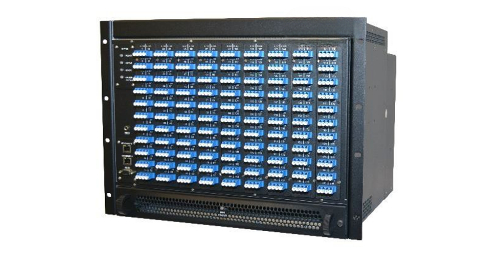
The HC-S320 optical switch uses the industry's most advanced 3D optical technology and has been deployed in more than 500,000 fiber connections worldwide. The optical switch realizes the high reliability, low power consumption and miniaturization of the system, and brings great convenience to the real all-optical switching of telecom operators and data centers.
HC-S320 optical switch supports matrix all-optical switching ports, adopts MEMS (micro-electromechanical system) technology to intelligently manage single-mode optical fiber signals. This includes establishing connections, monitoring optical signals, and changing connections independent of data transfer rates and protocols. Any input fiber can be connected to any output fiber without any restrictions and obstacles.
The core of the HC-S320 optical switch is the MEMS switching module, referred to as (MSM). The input optical signal is connected to the MSM, and then the optical signal is directed to the destination output port. At the same time, the input and output signals pass through the wind detector, and the optical signal is separated and sent to the monitoring module (OMM), which accurately reads the input and output optical power information, and uses this information to optimize the MEMS and reflector by controlling the voltage of the micro-motor. deflection state to minimize insertion loss.
The mirror array used for light reflection, the transmission of optical signals in the HC-S320 optical path switch consists of three components,
(1)Input collimator array: Let the incident light be precisely aligned with the input reflector
(2)Mirror array: divided into input mirror array and output mirror array
(3)Output collimator array: couple the beam from the output mirror to the output fiber.
High-quality mirror arrays and collimators, as well as accurate control of mirror angles using electrostatic voltages, make the product indicators reach the highest level in the industry. The connection establishment time from any input port to output port is 25ms, and the typical value of insertion loss is less than 2dB. The management and control of the equipment are composed of high-reliability active and standby dual processors. Using TL1 language and SNMPv3 can realize complex control of HC-S320 optical switch, and also can carry out remote WEB management
through CORBA interface and GUI interface attached with the machine. The OpenFIow API based on Software Defined Networking (SDN) is also supported.
Applications:
HC-S320 optical switch is an intelligent optical fiber management system, which has flexible scalability and is not affected by
Limited to certain data protocols and speeds. It can be widely used in telecom operators, data centers and mission-critical scenarios.
1.Laboratory automation, test resource sharing and management Dynamic allocation of capacity and resources of optical fronthaul network and backhaul network in 2.5G wireless network
3.In the data center or relay business scheduling center, remote software control is used to replace the traditional distribution frame as the jumper principle, and the business and optical information resource scheduling are quickly opened.
4.Realize rapid disaster recovery at the optical network level
5.Rapid remote configuration, recovery and reconstruction of important gateway networks such as submarine optical cables
6.New high-end density CDC ROADM
7.FTTH network automatic deployment, automatic service activation and testing
8.Network security monitoring
Features:
1.Miniaturization: 640 (320*320) LC ports are supported on a 7U standard rack.
2.Low power consumption: 45W typical. Low cost: the average cost per port is low, and can be widely used in operator data centers and government departments.
3.Low delay: There is almost no delay to the passing optical signal.
4.Adaptability: Support all data transmission rates, all protocols, including 100G or higher, no need to upgrade equipment.
5.Reliability: Using the most advanced 3D MEMS technology recognized by the industry, more than 500,000 optical fiber connections have been deployed around the world.
6.Compatibility: Simple installation and easy integration. The system uses GUI or EMS network management. Support TL1 language, SNMP,
CORBA and OpenFlow.
7.Low loss: the typical insertion loss is less than 2dB.
8.Built-in optical power detection: real-time optical power detection for each input and output port, providing powerful network diagnosis function.
Product parameters: Optical indicators:
1.640 LC ports (support 320 output x320 input)
2.Insertion loss (EoL): 0.8dB min, 1.8dB typical, 3.0dB max (O, S, C bands)
3.Fiber type: single-mode fiber
4.Working wavelength range: 1260nm to 1630nm
5.Delay:<50ns
6.Optical path setup time: < 50 ms
7.Reconfiguration time (all ports):<200ms
8.Input optical power dynamic range: +5 dBm to -20 dBm
9.Number of exchanges/switches: 10^12
10.Optical crosstalk: -60 dB
11.Return loss (EoL): 41 dB typical, 35 dB minimum
Environmental indicators: Working environment:
1.Temperature: 5° to 55° C (41° to 130° F)
2.Humidity: 10% to 90%, non-condensing
3.Altitude:<1600 meters Non-working environment:
4.Temperature: -40° to +70° C (-40° to 158° F)
5.Humidity: 5% to 93%, non-condensing
6.Altitude:<12,000 meters
Power indicator:
1.Equipped with dual (A and B) 100 to 240V AC power modules
2.A and B power supply can be installed in the front or rear, and the power module can be replaced on site
3.Power consumption: 45 W typical
Mechanical index:
1.Dimensions: 17.5”W x 12.2”H x 19”D (445 x 310 x 483 mm)
2.Weight: 45 lbs. (20.5kg)
3.Shipping weight: 55 lbs. (25kg)
Passed testing standards:
1.Safety: UL 60950, EN 60950-1, CSA 69950
2.Electromagnetic Compatibility (EMI / EMC): FCC Part 15 Subpart B, GR-1089-CORE, EN 55022,
Class A, EN 55024
3.Environment: GR-63-CORE (NEBS), EN 300019
4.Vision safety: CFR Title 21 Part 1040 Class 1
5.I/P voltage: ANSI T1.315-2001
6.EU ROHS Directive (Directive 2011/65/EU)
Network management interface:
1.Physical interface: 2 Gigabit Ethernet interfaces, 1 serial port, and 1 external alarm interface.
2.User Interface/Command: Web GUI, TL1, SNMPv3, CORBA, OpenFlow and REST APIs
If you need more information , Please contact us .